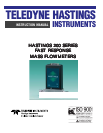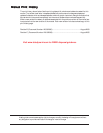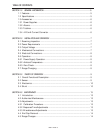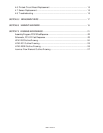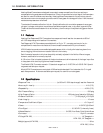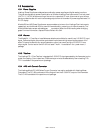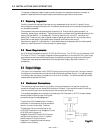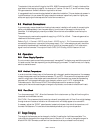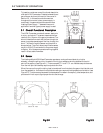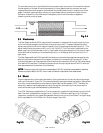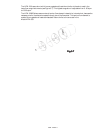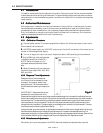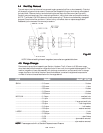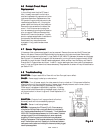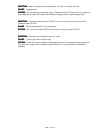
126B - PAGE 7
2.0 INSTALLATION AND OPERATION
This section is designed to assist in getting a new flowmeter into operation as quickly and easily as
possible. Please read the following thoroughly before attempting to install the instrument.
2.1 Receiving Inspection:2.1 Receiving Inspection:
2.1 Receiving Inspection:2.1 Receiving Inspection:
2.1 Receiving Inspection:
Carefully unpack the Hastings Flowmeter and any accessories that arrive with it. Inspect it for any
obvious signs of damage due to shipment. Immediately advise the carrier who delivered the shipment if
any damage is suspected.
Compare each component shipped against the packing list. Ensure that all parts are present (i.e.
flowmeter, power supply, cables, etc.). Optional equipment or accessories will be listed separately on the
packing list (see Section 1.4 - Accessories). There may also be one or more OPT- options on the
packing list. These normally refer to special ranges or special gas calibrations. They may also refer to
special helium leak tests or high pressure tests, or special modifications such as high
temperature or special O-ring materials. In most cases these are not separate parts, but rather special
options or modifications built into the flowmeter or power supply.
2.2 P2.2 P
2.2 P2.2 P
2.2 P
oo
oo
o
ww
ww
w
er Requirements:er Requirements:
er Requirements:er Requirements:
er Requirements:
All HFM Model Flowmeters require ±15 VDC @ ±50 mA max . The 15 VDC can vary between 14.25
VDC and 15.75 VDC. The supply voltage should be regulated with no more than 50 mV ripple. Surge
suppressers are recommended to prevent power line spikes from feeding through to the instruments.
These power requirements are satisfied by the Hastings Power Supply described in Section 1.4 -
Accessories.
2.3 Output 2.3 Output
2.3 Output 2.3 Output
2.3 Output
VV
VV
V
oltage:oltage:
oltage:oltage:
oltage:
The output of the flowmeter is a 0-5.00 VDC signal proportional to the flow rate. The output is sent to
the display and is available at terminals at the rear of the Hastings Power Supply. If a Hastings supply
is not being used, the output is available on pin 6 of the D connector. It is recommended that the load
resistance be no less than 2k Ohms.
2.4 Mechanical Connections:2.4 Mechanical Connections:
2.4 Mechanical Connections:2.4 Mechanical Connections:
2.4 Mechanical Connections:
The transducer may be oriented in any position, as long as the direction of gas flow through the
transducer follows the arrow marked on the bottom of the label. The preferred orientation is with the
inlet and outlet fittings in a horizontal plane with the connector pointing up.
The smallest passageway encountered on the Hastings HFM Flowmeter is .012" ID, therefore steps
should be taken to ensure proper filtering that
prevents blockage of these passageways.
There are two 8-32 threaded holes 1/4" deep in
the bottom of the transducer that can be used to
secure it to a mounting bracket, if desired.
The standard inlet and outlet fittings for the
HFM-229 Flowmeter are 1/4" Swagelok. For the
HFM-230, the fittings are 1/2"
Swagelok. Optional VCR and VCO fittings are
available from the factory. Viton O-rings are
standard with all fittings; Kalrez and
Neoprene O-rings are optional and can be
ordered from the factory.
Fig.2.1Fig.2.1
Fig.2.1Fig.2.1
Fig.2.1



